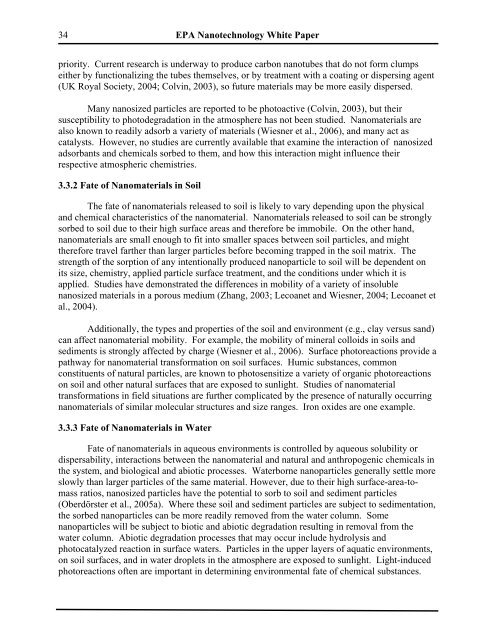Nanotechnology White Paper - US Environmental Protection Agency
Nanotechnology White Paper - US Environmental Protection Agency
Nanotechnology White Paper - US Environmental Protection Agency
You also want an ePaper? Increase the reach of your titles
YUMPU automatically turns print PDFs into web optimized ePapers that Google loves.
34 EPA <strong>Nanotechnology</strong> <strong>White</strong> <strong>Paper</strong><br />
priority. Current research is underway to produce carbon nanotubes that do not form clumps<br />
either by functionalizing the tubes themselves, or by treatment with a coating or dispersing agent<br />
(UK Royal Society, 2004; Colvin, 2003), so future materials may be more easily dispersed.<br />
Many nanosized particles are reported to be photoactive (Colvin, 2003), but their<br />
susceptibility to photodegradation in the atmosphere has not been studied. Nanomaterials are<br />
also known to readily adsorb a variety of materials (Wiesner et al., 2006), and many act as<br />
catalysts. However, no studies are currently available that examine the interaction of nanosized<br />
adsorbants and chemicals sorbed to them, and how this interaction might influence their<br />
respective atmospheric chemistries.<br />
3.3.2 Fate of Nanomaterials in Soil<br />
The fate of nanomaterials released to soil is likely to vary depending upon the physical<br />
and chemical characteristics of the nanomaterial. Nanomaterials released to soil can be strongly<br />
sorbed to soil due to their high surface areas and therefore be immobile. On the other hand,<br />
nanomaterials are small enough to fit into smaller spaces between soil particles, and might<br />
therefore travel farther than larger particles before becoming trapped in the soil matrix. The<br />
strength of the sorption of any intentionally produced nanoparticle to soil will be dependent on<br />
its size, chemistry, applied particle surface treatment, and the conditions under which it is<br />
applied. Studies have demonstrated the differences in mobility of a variety of insoluble<br />
nanosized materials in a porous medium (Zhang, 2003; Lecoanet and Wiesner, 2004; Lecoanet et<br />
al., 2004).<br />
Additionally, the types and properties of the soil and environment (e.g., clay versus sand)<br />
can affect nanomaterial mobility. For example, the mobility of mineral colloids in soils and<br />
sediments is strongly affected by charge (Wiesner et al., 2006). Surface photoreactions provide a<br />
pathway for nanomaterial transformation on soil surfaces. Humic substances, common<br />
constituents of natural particles, are known to photosensitize a variety of organic photoreactions<br />
on soil and other natural surfaces that are exposed to sunlight. Studies of nanomaterial<br />
transformations in field situations are further complicated by the presence of naturally occurring<br />
nanomaterials of similar molecular structures and size ranges. Iron oxides are one example.<br />
3.3.3 Fate of Nanomaterials in Water<br />
Fate of nanomaterials in aqueous environments is controlled by aqueous solubility or<br />
dispersability, interactions between the nanomaterial and natural and anthropogenic chemicals in<br />
the system, and biological and abiotic processes. Waterborne nanoparticles generally settle more<br />
slowly than larger particles of the same material. However, due to their high surface-area-tomass<br />
ratios, nanosized particles have the potential to sorb to soil and sediment particles<br />
(Oberdörster et al., 2005a). Where these soil and sediment particles are subject to sedimentation,<br />
the sorbed nanoparticles can be more readily removed from the water column. Some<br />
nanoparticles will be subject to biotic and abiotic degradation resulting in removal from the<br />
water column. Abiotic degradation processes that may occur include hydrolysis and<br />
photocatalyzed reaction in surface waters. Particles in the upper layers of aquatic environments,<br />
on soil surfaces, and in water droplets in the atmosphere are exposed to sunlight. Light-induced<br />
photoreactions often are important in determining environmental fate of chemical substances.

















